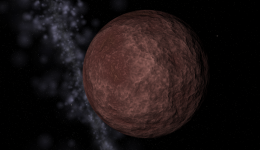Hunting for transits of Super-Earth GJ 581e

(PhysOrg.com) -- An international team of astronomers has ruled out transits of a water-rich or hydrogen-helium atmosphere planet for Gliese 581e. The host star itself is relatively quiet which means good news for the potential habitability of at least one of its planets.
The study was conducted using observations acquired by MOST (Microvariability & Oscillations of STars), Canada's only space telescope.
At a distance of 20 light-years from Earth, Gliese 581 is a star with a radius only a third that of the Sun. Planet e is the innermost of the four (possibly up to 6) planets that orbit this star. It is also the least massive, with a minimum mass of only twice that of the Earth. All the known planets around GJ 581 have been detected via the Doppler method, where the wobble induced in the star by its orbiting companions can be measured from the wavelength shift in the star's spectral lines. Planets b, c, d, and e were found by a team of French and Swiss astronomers, while planets f and g (both of which remain to be confirmed) were announced by the Lick-Carnegie Exoplanet Survey.
The Gliese 581 system has attracted a lot of attention recently, after a group of researchers from the Institut Pierre Simon Laplace in Paris concluded that planet d "is the first discovered terrestrial-mass exoplanet in the habitable zone". They found that, despite the small amount of light Gliese 581d receives from its star, a carbon dioxide atmosphere could maintain temperatures above the freezing point of water at the surface.
If the orbital inclination of a planetary system is just right, then one or more planets may be observed to cross (transit) the disk of the star, dimming the brightness of the star by a tiny fraction. By measuring this effect, it is possible to derive the size of the planet.
If Gliese 581e transits its host star, then it must have a radius smaller than 1.4 times that of the Earth since a larger planet would have been detected by MOST. In terms of composition, this suggests that planet e does not have a hydrogen or helium atmosphere, nor does it contain more than 25% water. Therefore it must be a solid rocky planet. However, if the planet does not transit, its size and therefore its composition cannot be constrained, but the inclination of its orbit can.
"Although transits were not detected for Gliese 581e, this result allows us to place limits on the planet's physical and orbital properties, in addition to letting other astronomers know whether they should keep searching," says Diana Dragomir, a PhD student at the University of British Columbia who led the study.
Another key finding of the study is the low level of activity of the host star. As is the case for the Sun, such stability is favorable to the development of life on Gliese 581d or g. It also indicates that the star and its planetary system are likely to be quite old, thus having allowed plenty of time for life to arise.
One way to shed more light on the properties of the Gliese 581 system is by directly measuring the spectra of the planets' atmospheres in order to determine their composition. Such observations will paint a clearer picture of the system and help settle the question of habitability. Although this approach is beyond the capabilities of current instruments, ongoing work suggests it will become feasible in the foreseeable future.
These results have been presented at the Exploring Strange New Worlds conference in Flagstaff, Arizona (May 2011), and are being reprised this week at the CASCA 2011 meeting in London, ON, Canada.
Provided by Canadian Astronomical Society





















